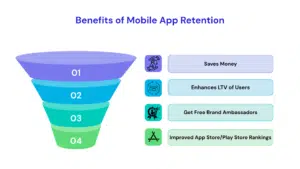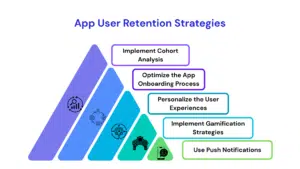Evidence has proven that acquiring a new customer for your mobile app is more expensive than retaining an existing one! Following that, retention is also one of the critical metrics for you to assess the overall user experience quotient of your mobile app.
Experts believe that achieving around 20% of app retention can drive around 80% of annual profit for your business! Therefore, it is always advisable to drive your strong focus on offering your existing app customers the best experience rather than spending all your marketing dollars on bringing in new ones.
However, for that, you need to have effective mobile app retention strategies in place!
So, if you are struggling to achieve a good mobile app user retention rate through the usual strategies, this guide will help you achieve new paradigms in the process. Read along till the end to understand what mobile app retention is, and how you can implement new strategies to boost it.
What is Mobile App User Retention?
Mobile app retention or user retention represents your business’s capability of enticing customers to keep coming back to your services or products. With more existing app users retained, you can expect to have continued transactions from them, even after the initial period.
In simple words, a user first downloads a mobile app mostly out of curiosity, social influence, or word-of-mouth recommendation. Later, it depends on the overall user experience and the value that the app offers for enticing that user to turn up again. In case that doesn’t happen and the user uninstalls the app, it indicates that the company can’t retain its users well.
Therefore, efficient mobile app user retention strategies are essential for a business to attain success by securing a considerable amount of repeat purchases. The user retention rate will decrease as the days pass, and that’s inevitable for almost every business. However, using clever strategies can help you keep your active users engaged for a very long time.
Benefits of Prioritizing Mobile App Retention for Your Business
When you seek to prioritize mobile app retention for your business, you are organically convincing your customers to hold onto your business application for a prolonged period. You can do it by creating a smooth, engaging, and rewarding experience for users. The more time a user engages with your mobile app, the better opportunities you can create for them to take purchase actions.
Here are some of the benefits to help you feel more enticed about integrating user retention strategies for your app-driven business:
1. Saves Money:
It is great to have a daily download counter in thousands, but that doesn’t guarantee you a stable user base and revenue stream. Therefore, investing in retaining the existing users will help you save 4x the money you spend on acquiring new customers. In short, your user acquisition efforts must be followed by the retention strategies in order to give you the maximum value for the dollars you spend.
2. Enhances LTV (Lifetime Value) of Users:
Retaining your app users will help it grow sustainably, as the strategies you use will directly impact the LTV of users. It means, when users actively engage for a prolonged period of time with your app, you will be able to maximize revenue generation from them. So, if your customers continue to use the app regularly, the LTV associated with them will increase, whereas the overall cost of acquisition will decrease, which is a win-win for you!
3. Get Your Free Brand Ambassadors:
No one can better promote your app, brand, or business offerings than happy customers! The app users who attain a positive experience on your app and are convinced to keep it for a long time can be your brand ambassadors. Their word-of-mouth recommendations and positive reviews will eventually get your app some new user downloads, and also save you from spending on expensive marketing strategies.
4. Improved App Store/Play Store Rankings:
The App Store or Play Store algorithms are meant to favor the mobile apps that have higher user retention rates. It is a crucial factor that leads a mobile app to get better visibility among the target users, giving it more downloads and new potential users.
Steps to Calculate the App User Retention Rate
Before implementing the improvement strategies, you must get an insight into what your current app retention rate is. Therefore, adhere to the steps and formula specified below for seamlessly calculating your mobile app retention rate:
1. Choose a Specific Time Frame:
You can measure the retention rate for your desired time frame, such as a week, a month, or a quarter.
2. Take Count of Initial Users:
Count the total number of users who installed and used your app at the start of your chosen time frame.
3. Count Your Retained Users:
Check the end of your time frame, and now count the total number of those initial active users who are still using your application.
4. Use the Formula for Calculating the Retention Rate:
User Retention Rate = (Number of Retained Users / Initial Number of Users) * 100
Use this formula with the collected data from the earlier steps to get your total percentage of user retention for the chosen time frame.
NOTE: As per several factors and industry benchmarks, a mobile app retention rate of 10% to 30% for a 90-day time period is referred to as good.
5 Best Mobile App User Retention Strategies 2025
If your user retention rate is below average or isn’t optimal at all, here are some proven strategies to help you scale it exponentially and secure higher revenue:
1. Implement Cohort Analysis to Track Your User Data
One of the best ways to measure your app retention rate is, implementing cohort analysis. It is the approach when you are grouping your users into specific categories or cohorts, based on their behavior in a specific time frame.
As part of this analysis, you will try to identify varying reasons why your customers stop using the app. Following that, you can plan adequate action to retain users across all of those groups or cohorts. When executing cohort analysis, you can take almost every bit of data that you can collect, such as:
- You can collect heatmap insights to review the touch gestures of your users on the app. This way, you can determine the potential obstructions your users face in terms of navigation or taking actions while using your app.
You can also create & review visual recordings, where you will be replaying actual user sessions. Using this data, you can identify how people engage with your app after downloading.
2. Optimize the App Onboarding Process
Every time a user downloads an app, he/she want to have an enjoyable and seamless experience. Therefore, the overall onboarding experience must be optimized and streamlined to adhere to the users’ expectations.
You ought to reduce the onboarding friction for your users by implementing certain strategies, such as:
- Unless necessary, you must push the sign-up step to the end of a user’s journey, instead of putting it at the first, right after the app is downloaded.
- Show users the best features of your app when they access it for the first time, convincing them that they have made the right choice.
- Design or optimize the onboarding experience of your mobile app to give users a gentle understanding of how to navigate and use it, which might lead them to be long-term users.
3. Personalize the User Experiences
Use your existing customer data, such as their usage patterns or demographics, for tailoring the user experience of your app. Beyond that, you can also collect data on specific goals of users with your app, and what specifically interests them.
Such information will help you customize the overall app experience and provide your users with personalized content, unique onboarding, and a tailored experience. Due to personalized onboarding flows, your app would become more relevant for the users and would entice them to use it for a prolonged period.
4. Implement Gamification Strategies
One of the best ways to keep your users engaged with your mobile app is to integrate gamification elements into it. They are nothing but certain game-like features capable of making your app seem more fun as well as rewarding.
Such gamification strategies often reward users with incentives for fulfilling certain milestones. For instance, a health tracker app rewards users with badges when they achieve certain fitness milestones.
5. Use Push Notifications
Push notifications can help you deliver relevant and timely information to users, even if they aren’t actively using your mobile application. This feature is proven effective in establishing a strong user engagement, which further leads to higher retention rates.
If you have convinced your users through the initial impression to enable push notifications for your app, the next step is to be strategic about sending messages. Some tips that you must follow are:
- Don’t send push notifications to all your users at the same time. You need to know that your users might possibly be in different time zones, and receiving notifications at odd hours might result in a poor experience.
- Give your push notifications a personalized touch by either adding the users’ names or tailoring them based on the users’ behavior.
- Avoid sending in too many notifications in a short time span!
Parting Words
This is the complete guide you will need in order to boost your mobile app retention rate with effective strategies. However, achieving a good retention rate isn’t a one-time gig, as it demands that you implement continuous efforts over time and also try new strategies.
Beyond the use of these strategies listed above, you must also consider optimizing your mobile app on periodic intervals to introduce new features, functionalities, and design elements to it. This way, your app will always stay updated with the current market trends and will continue to interest the users.
At Simpalm, we help you adhere to all of these mobile app retention strategies and more, as part of our ongoing app support and maintenance solutions. To know more, feel free to reach out!

 App Development
App Development Web Engineering
Web Engineering AI Services
AI Services Startups
Startups Health / Fitness
Health / Fitness Education
Education Social
Social Nonprofit
Nonprofit Fintech
Fintech Logistics
Logistics Government
Government HR Software
HR Software About Simpalm
About Simpalm Our News
Our News Client Testimonials
Client Testimonials Careers
Careers Awards
Awards Resources
Resources Information
Information




